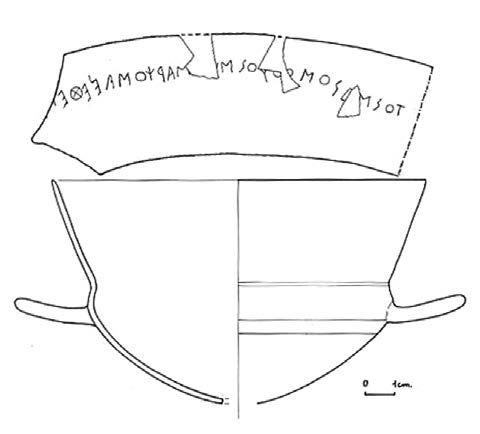EpiDoc XML:
IGCyr1101002
Trismegistos ID:
738631
Source description
Support: Fragmentary Chiote chalice, broken off at left and bottom, keeping one handle and about one half of the belly with its upper edge (w: 0.078 × h: 0.08 × d: 0.003; diameter 0.127).
Layout: Scratched on the outer side of the belly, at 0.009 to 0.026 from the upper rim.
Letters: 0.002 to 0.006; right-to-left, three-strokes iota, crossed theta, san for sibilant, trident-shaped chi.
Date: Las third of seventh century BC (context, lettering).
Findspot: Found by M. Luni in 2006 at Cyrene ➚: temple of the Dioscuri on the Acropolis ridge (once said 'tempio ipetrale').
Place of origin: Findspot.
Last recorded location: Cyrene Museum (Storeroom of the Italian mission), CA06S3US3. Studied by O.Mei in 2006 at Shahat: in the Storeroom of the Italian missions. Not seen by IGCyr team.
Text constituted from: Transcription from photograph (SMM).
Bibliography
Marengo 2008, pp. 26-33 (ph., dr.) (= Marengo 2010, pp. 120-127) and Dobias-Lalou, BE, 2010.631, whence SEG, 58.1838; IGCyr 110100 ➚. Cf. Dobias-Lalou 2015, whence SEG, 65.2015; Dobias-Lalou 2013-2014, p. 185; Antonini 2016, whence SEG, 66.2329; Marengo 2016, p. 168-169; , p. 164; Rosamilia 2023, p. 382, number 108 (text).
Text
Apparatus
1: Μ̣[c. 1 - 2]σαρχος: Μ̣[νά?]σαρχος Rosamilia 2023; Μ̣[νά]σαρχος Dobias-Lalou, BE; [c. 2 - 3]σαρχος Marengo 2008 perhaps Ἁγέσαρχος, Λύσαρχος or Σόσαρχος
French translation
[---]sarkhos a consacré (scil. cette coupe) aux Dioscures.
English translation
[---]sarchos dedicated (scil. this cup) to the Dioscuri.
English translation
[---]sarchos ha dedicato (scil. questa coppa) ai Dioscuri.
Arabic translation
[---] سارخوس كرَّس (هذه الكأس) للديوسكوري.
Commentary
The very short vertical stroke preserved at the beginning of the dedicant's name might be part of a mu or a san. So the very common Cyrenaean name Μνάσαρχος would be a favourite, but Σώσαρχος, suggested by Marengo, would also fit the gap perfectly.
This graffito has demonstrated the place of the Dioskoureion already mentioned by Pindar (Pyth. 5. 9-11).
The trident-shaped chi, along with other letters already attested in the archaic alphabet of Cyrene, was probably brought by Rhodian immigrants. Two other instances of that chi occur at IGCyr0019202 and IGCyr0004302 (see now Dobias-Lalou 2015, pp. 69-70). This fact has chronological implications. The Rhodian immigration has been traditionally linked with Battos II's invitation to all Greeks around 580/570 BC. However, argues that besides Herodotos' story exists a strong Rhodian tradition of participating in the foundation around 630 BC., of which the trident-shaped chi would be a proof, whence a possible date of this dedication already in the last third of the seventh century BC. Moreover, this shape of chi belongs, amongst the three cities of Rhodes, to Lindos only and bings new light into the foundation of Cyrene.
CC BY-NC-SA 4.0 Deed Attribution-NonCommercial-ShareAlike 4.0 International License.
All citation, reuse or distribution of this work must contain a link back to DOI: https://doi.org/10.60760/unibo/igcyrgvcyr2 and the filename (IGCyr000000 or GVCyr000), as well as the year of consultation.


